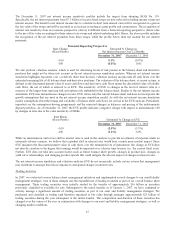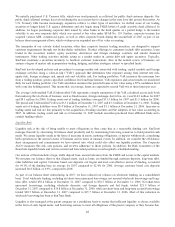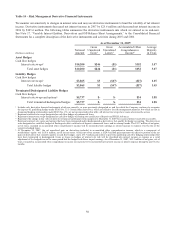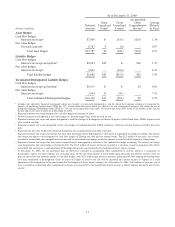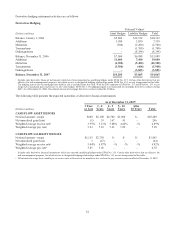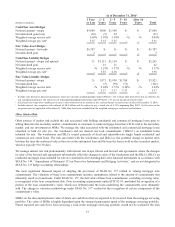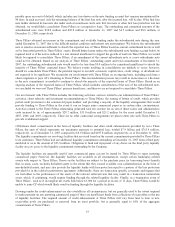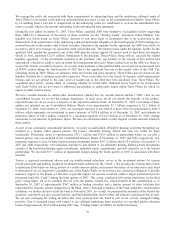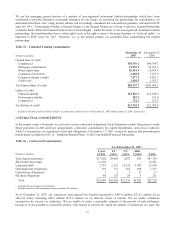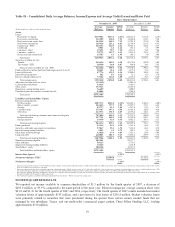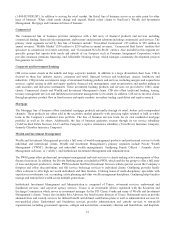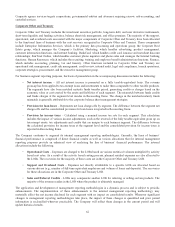SunTrust 2007 Annual Report Download - page 67
Download and view the complete annual report
Please find page 67 of the 2007 SunTrust annual report below. You can navigate through the pages in the report by either clicking on the pages listed below, or by using the keyword search tool below to find specific information within the annual report.payable upon an event of default, which includes any loss drawn on the note funding account that remains unreimbursed for
90 days. In such an event, only the remaining balance of the first loss note, after the incurred loss, will be due. If the first loss
note holder declared its loss note due under such circumstances and a new first loss note or other first loss protection was not
obtained, we would likely consolidate Three Pillars on a prospective basis. The outstanding and committed amounts of the
subordinated note were $20.0 million and $20.0 million at December 31, 2007 and $6.5 million and $8.0 million, at
December 31, 2006, respectively.
Three Pillars obtained an increase in the commitment and available funding under the subordinated note during the year
ended December 31, 2007 due to the difficult market condition and interest rate environment. We believe the subordinated
note is sized in an amount sufficient to absorb the expected loss of Three Pillars based on current commitment levels as well
as for forecasted growth in Three Pillars’ assets. Should future losses reduce the subordinated note funding account below its
required level or if the note is reduced to a size deemed insufficient to support the growth of assets in Three Pillars, we would
likely be required to consolidate Three Pillars, if an amendment of the current subordinate note or a new subordinate note
could not be obtained. Based on our analysis of Three Pillars’ outstanding assets and total commitments at December 31,
2007, the outstanding subordinated note would need to be less than $9.0 million to be considered insufficient to absorb the
majority of Three Pillars’ expected losses. We believe events resulting in consolidation are unlikely to occur; however,
should we consolidate Three Pillars, the potential impact to our debt covenants, capital ratios, credit ratings, or dividends are
not expected to be significant. We reconsider our involvement with Three Pillars on an ongoing basis, including each time a
client originates or pays off a financing in Three Pillars. This reconsideration process may result in an increase or a decrease
in the note commitment, as needed to continue to absorb the majority of the expected losses of Three Pillars. Based on an
ongoing analysis of the expected losses of Three Pillars, which includes consideration of the size of the subordinated note,
we concluded we were not Three Pillars’ primary beneficiary, and thus we are not required to consolidate Three Pillars.
Our involvement with Three Pillars includes the following activities: services related to our administration of Three Pillars’
activities, client referrals and investment recommendations to Three Pillars; the issuing of letters of credit, which provides
partial credit protection to the commercial paper holders; and providing a majority of the liquidity arrangements that would
provide funding to Three Pillars in the event it can no longer issue commercial paper or in certain other circumstances.
Activities related to the Three Pillars relationship generated total fee revenue for us, net of direct salary and administrative
costs incurred by us, of approximately $28.7 million, $31.0 million and $25.2 million for the years ended December 31,
2007, 2006, and 2005, respectively. There are no other contractual arrangements we plan to enter into with Three Pillars to
provide it additional support.
Off-balance sheet commitments in the form of liquidity facilities and other credit enhancements provided by us to Three
Pillars, the sum of which represents our maximum exposure to potential loss, totaled $7.9 billion and $763.4 million,
respectively, as of December 31, 2007 compared to $8.0 billion and $697.8 million, respectively, as of December 31, 2006.
The liquidity commitments are revolving facilities that are sized based on the current commitments provided by Three Pillars
to its customers. Three Pillars had one additional liquidity commitment outstanding at December 31, 2007 from a third party
unrelated to us in the amount of $25.0 million. Obligation to fund and repayment of any draws on the third party liquidity
facility are pari passu to the liquidity commitment outstanding by the Company.
The liquidity facilities are generally used if new commercial paper can not be issued by Three Pillars to repay maturing
commercial paper. However, the liquidity facilities are available in all circumstances, except certain bankruptcy-related
events with respect to Three Pillars. Draws on the facilities are subject to the purchase price (or borrowing base) formula
that, in many cases, excludes defaulted assets to the extent that they exceed available over-collateralization in the form of
non-defaulted assets, and may also provide the liquidity banks with loss protection equal to a portion of the loss protection
provided for in the related securitization agreement. Additionally, there are transaction specific covenants and triggers that
are tied either to the performance of the assets of the relevant seller/servicer that may result in a transaction termination
event, which, if continuing, would require funding through the related liquidity facility. Finally, in a termination event of
Three Pillars’, such as if its tangible net worth falls below $5,000 for a period in excess of 15 days, Three Pillars would be
unable to issue CP which would likely result in funding through the liquidity facilities.
Drawings under the credit enhancement are also available in all circumstances, but are generally used to the extent required
to make payment on any maturing commercial paper if there are insufficient funds from collections of receivables or the use
of liquidity facilities. The required amount of credit enhancement at Three Pillars will vary from time to time as new
receivables pools are purchased or removed from its asset portfolio, but is generally equal to 10% of the aggregate
commitments of Three Pillars.
55




